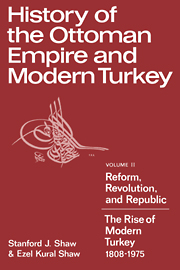Book contents
- Frontmatter
- Contents
- List of Tables
- Preface
- Preface to the second printing
- List of Abbreviations
- Note on Pronunciation
- Map of the Growth of the Ottoman Empire, 1280–1683
- Map of the Decline of the Ottoman Empire, 1683–1975
- 1 The Beginnings of Modern Ottoman Reform: The Era of Mahmut II, 1808–1839
- 2 The Era of Modern Reform: The Tanzimat, 1839–1876
- 3 Culmination of the Tanzimat: The Reign of Abdulhamit II, 1876–1909
- 4 The Young Turk Period, 1908–1918
- 5 The Turkish War for Independence, 1918–1923
- 6 The Turkish Republic, 1923–1975
- Appendix
- Bibliography: History of the Ottoman Empire and Modern Turkey, 1808–1975
- Index
5 - The Turkish War for Independence, 1918–1923
Published online by Cambridge University Press: 20 May 2010
- Frontmatter
- Contents
- List of Tables
- Preface
- Preface to the second printing
- List of Abbreviations
- Note on Pronunciation
- Map of the Growth of the Ottoman Empire, 1280–1683
- Map of the Decline of the Ottoman Empire, 1683–1975
- 1 The Beginnings of Modern Ottoman Reform: The Era of Mahmut II, 1808–1839
- 2 The Era of Modern Reform: The Tanzimat, 1839–1876
- 3 Culmination of the Tanzimat: The Reign of Abdulhamit II, 1876–1909
- 4 The Young Turk Period, 1908–1918
- 5 The Turkish War for Independence, 1918–1923
- 6 The Turkish Republic, 1923–1975
- Appendix
- Bibliography: History of the Ottoman Empire and Modern Turkey, 1808–1975
- Index
Summary
The Turks were the only one of the Central Powers able to overturn immediately the vindictive settlements imposed by the Allies following World War I. Because Turkish resistance ultimately was led to success by Mustafa Kemal, it long has been assumed that he created it as well. He did, indeed, do more than anyone else to create the Turkish Republic on the ruins of the Ottoman Empire, but he accomplished this by bringing together elements of resistance that had already emerged. He coordinated their efforts, expressed their goals, personified their ambitions, and led them to victory.
The National Resistance Forces
Resistance appeared from the first days of the occupation while Mustafa Kemal still was in Cilicia. It came initially from within the Istanbul government itself, where many of the officials organized the secret Outpost Society (Karakol Cemiyeti) shortly after the armistice and used their positions to thwart the Allied demands as well as to send arms and ammunition to Anatolia. Small boats were loaded in the capital in the cover of darkness and sent out into the Aegean and the Black Sea to deliver their valuable cargoes. There is considerable evidence that Talat Paşa himself stimulated the first resistance movements in Thrace before fleeing the country and that resistance in Istanbul was organized within the Ministry of Foreign Affairs. When Mustafa Kemal, Kâzim Karabekir, and other leading officers returned to Istanbul to protest the demobilization orders, they were warmly received by the sultan and others and appointed to important positions in the areas remaining under direct Ottoman authority, where they could lead opposition almost under the noses of the Allies.
- Type
- Chapter
- Information
- History of the Ottoman Empire and Modern Turkey , pp. 340 - 372Publisher: Cambridge University PressPrint publication year: 1977



